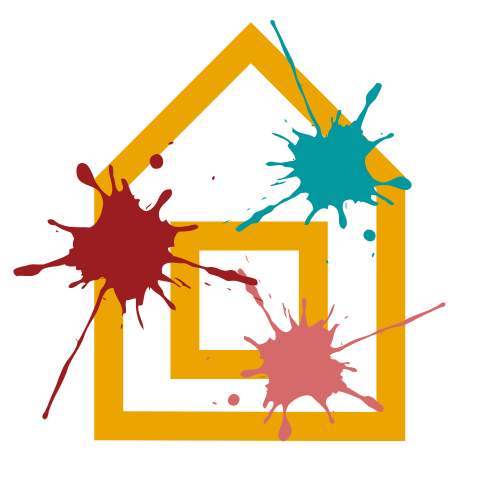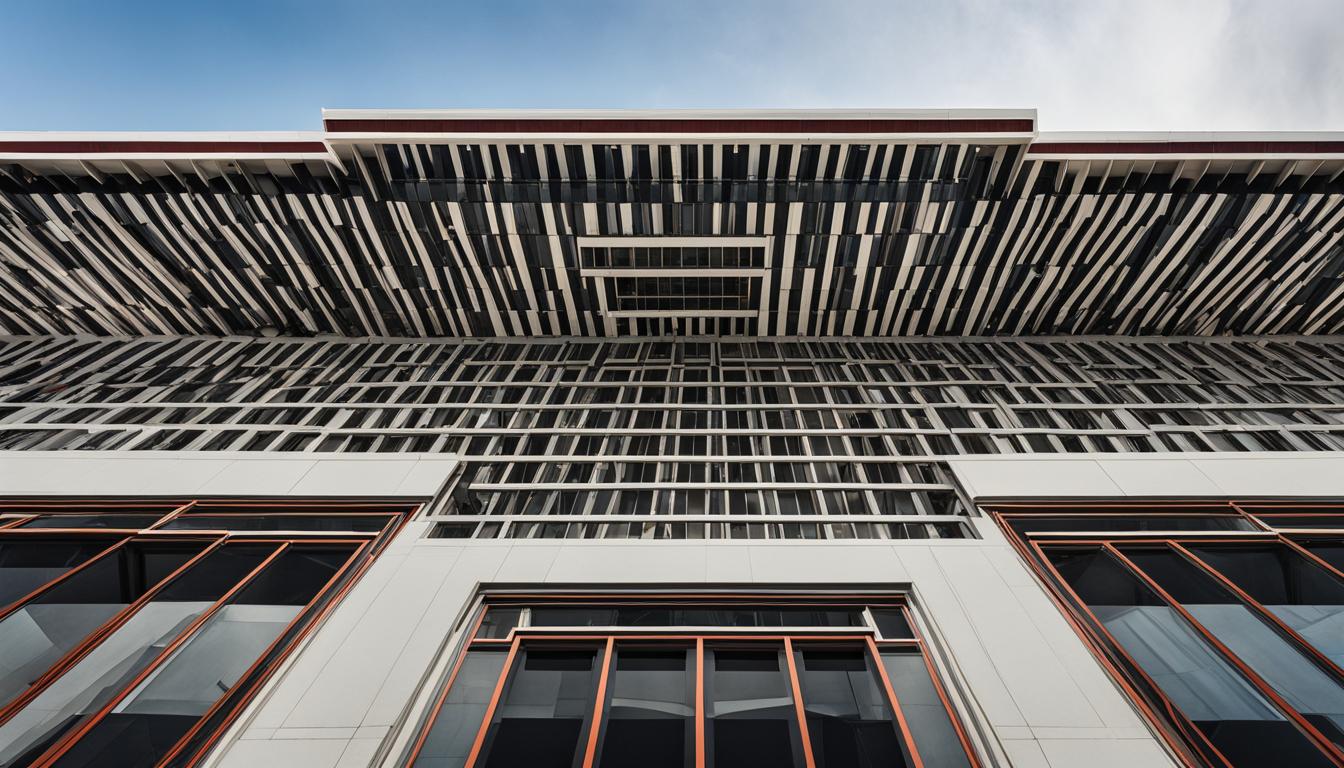Welcome to our article exploring the exquisite and timeless Art Deco aesthetic and how it can be infused into modern interiors. Art Deco design emerged in the early 20th century, and it remains a popular and influential movement in architecture, art, and interior design. Its distinctive elements, including geometric shapes, bold lines, and lavish materials, have captured our imagination for decades.
The Art Deco style is synonymous with luxury and glamour. Whether it’s the bold skyscrapers of New York City or the sleek interiors of Hollywood’s Golden Age, Art Deco always commands attention. It’s a design philosophy that celebrates modernity and progress while honoring the craftsmanship and elegance of the past.
In this article, we’ll explore the key elements of Art Deco design and how to incorporate them into modern interiors to create a luxurious and timeless space. From Art Deco architecture to furniture and decor, we’ll provide practical tips and inspiration to help you embrace this iconic aesthetic in your home or business.
Key Takeaways:
- Art Deco design incorporates geometric shapes, bold lines, and luxurious materials.
- The Art Deco era emerged in the early 20th century and remains influential today.
- Art Deco celebrates modernity while honoring the craftsmanship and elegance of the past.
- Infusing Art Deco elements into contemporary spaces can create a luxurious and timeless look.
- We’ll explore practical tips and inspiration for bringing Art Deco into your home or business.
Exploring the Art Deco Era
When we talk about the Art Deco aesthetic, it’s important to understand the era that gave birth to this iconic style. The Art Deco era spanned from the 1920s to the 1930s and was a time of great cultural and historical significance. The aftermath of World War I brought about a desire for a new, modern aesthetic that would represent progress and optimism.
The Art Deco style was heavily influenced by various art movements of the time, including Cubism and Futurism. It was also inspired by the glamour and luxury associated with the Jazz Age, with many of its design elements reflecting the opulence of the era.
One of the defining characteristics of the Art Deco era was its focus on industrialization and mass production. This led to the widespread use of new materials such as chrome, glass, and plastics, which were incorporated into Art Deco architecture and design to create a bold and futuristic look.
The Art Deco style also played a significant role in the history of design, influencing everything from furniture and fashion to jewelry and graphic design. Its legacy can still be seen today in contemporary design, with many designers drawing inspiration from the iconic Art Deco aesthetic.
Key Takeaways:
- The Art Deco era spanned from the 1920s to the 1930s and was a time of great cultural and historical significance.
- It was heavily influenced by various art movements of the time, including Cubism and Futurism.
- The Art Deco style was characterized by its focus on industrialization, mass production, and the use of new materials.
- The Art Deco legacy can still be seen in contemporary design, with many designers drawing inspiration from its iconic aesthetic.
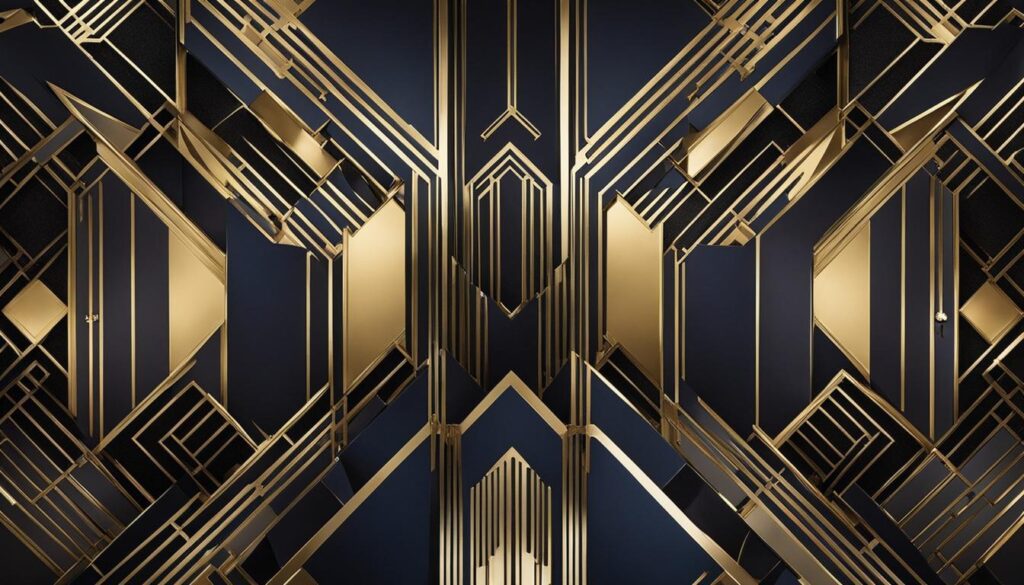
Key Elements of Art Deco Design
Art Deco design is defined by a distinctive set of elements that come together to create its glamorous and luxurious aesthetic. These design elements are a blend of various styles and influences, including Cubism, Futurism, and modernism, among others. Here are some of the key Art Deco elements to consider when creating an Art Deco-inspired interior:
Geometric Shapes and Bold Lines
Art Deco design features an abundance of geometric shapes and bold lines, often arranged in symmetrical patterns. These shapes can be seen in everything from architecture to furniture, and they are typically characterized by clean, sharp lines and a sense of order and stability. Straight lines, triangles, zigzags, and chevrons are all common motifs in Art Deco design.
Luxurious Materials
Art Deco design is all about luxury, and this is reflected in the materials used to create it. Common materials used in Art Deco interiors include exotic woods, metals like chrome and brass, and luxurious fabrics like velvet and silk. These materials are often paired with rich colors like burgundy, emerald green, and navy blue.
Intricate Detailing
Art Deco design is known for its intricate and ornate detailing, particularly in architecture and furniture. This can include everything from delicate filigree to bold, statement-making motifs like sunbursts and zigzags. Whether in the form of a patterned rug or an elaborate light fixture, these details add depth and interest to Art Deco interiors.
Repeating Patterns
Repeating patterns are another key feature of Art Deco design. These patterns can be seen in everything from wallpaper to rugs and are often inspired by nature, with motifs like palm fronds and peacock feathers being popular choices. These patterns help create a sense of unity and cohesion within an Art Deco interior.
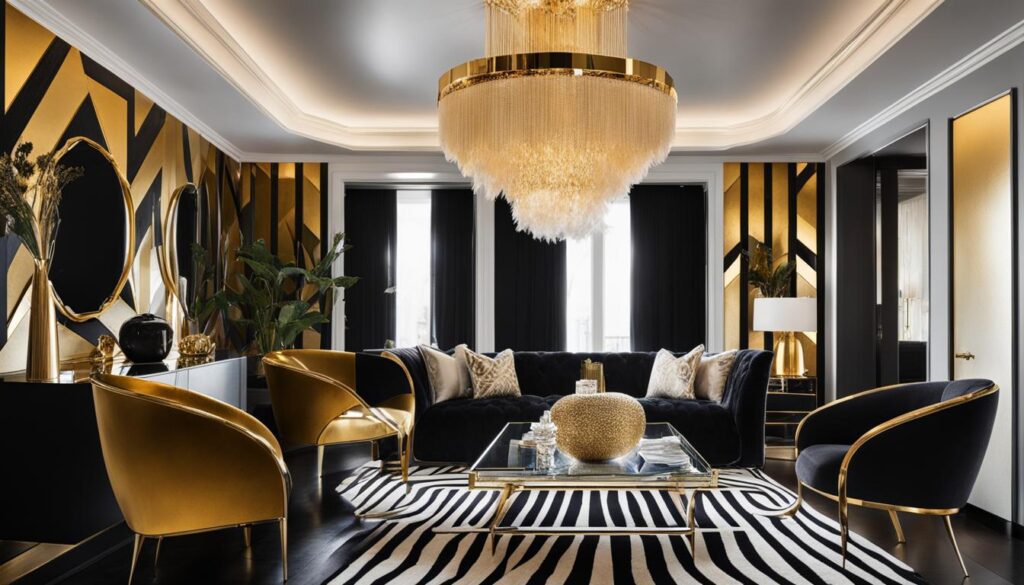
By incorporating these key Art Deco elements into your interior design, you can create a space that is both sophisticated and glamorous. Whether you opt for bold, geometric shapes or intricate detailing and luxurious materials, Art Deco design is sure to add a touch of timeless elegance to any space.
Bringing Art Deco to Life in Contemporary Spaces
When it comes to creating an Art Deco interior, furniture plays a key role in setting the tone. Look for pieces that feature geometric shapes, bold lines, and luxurious materials such as velvet and marble. A statement sofa or armchair in a vibrant hue like emerald green or deep navy can be the perfect centerpiece for your Art Deco-inspired living room.
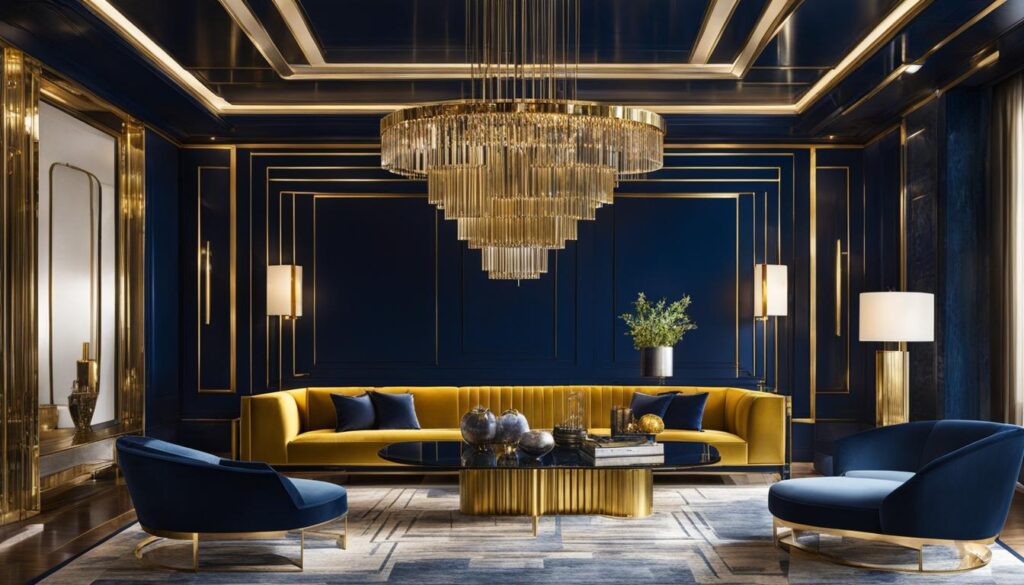
Another way to infuse Art Deco into your space is through lighting. Opt for fixtures with sleek and angular designs, like a chandelier with crystal accents or a table lamp with a brass finish and geometric base.
When it comes to color, Art Deco interiors often feature bold and contrasting hues such as black and white, rich jewel tones, and metallic accents. Incorporating these shades into your color scheme through accessories like throw pillows or a statement rug can help tie the room together.
Don’t forget about the details – Art Deco is all about intricate patterns and detailing. Incorporate these elements through statement wallpaper, decorative mirrors, and unique accents like a vintage record player or antique perfume bottles.
Overall, bringing an Art Deco aesthetic to your contemporary space is all about finding the right balance between luxurious glamour and modern sophistication. With the right furniture, lighting, and accessories, you can create a space that pays homage to this iconic design style while still feeling fresh and relevant.
Conclusion
As we conclude our exploration of the Art Deco aesthetic, we cannot ignore the influence this trend has had on fashion and jewelry. Art Deco jewelry, with its sleek geometric shapes and intricate detailing, remains a popular choice for those seeking a touch of vintage glamour.
In the world of fashion, Art Deco style can be seen in the use of luxurious fabrics, bold prints, and statement accessories. From flapper dresses to tailored suits, the Art Deco era continues to inspire designers and fashionistas alike.
Whether you choose to incorporate Art Deco elements through your jewelry and clothing choices or through your interior design, one thing is certain: this timeless aesthetic will continue to capture our hearts and imaginations for years to come.
FAQ
What is the Art Deco aesthetic?
The Art Deco aesthetic is a style that emerged in the 1920s and 1930s, characterized by bold geometric shapes, luxurious materials, and intricate detailing. It is known for its glamorous and elegant design elements.
How can I incorporate the Art Deco aesthetic into my contemporary space?
To bring the Art Deco aesthetic into your space, you can start by selecting furniture pieces that have Art Deco-inspired design elements, such as sleek lines and bold shapes. You can also incorporate luxurious materials like velvet, marble, and gold accents. Accessories such as geometric mirrors and Art Deco-inspired artwork can add the finishing touches.
What are the key elements of Art Deco design?
The key elements of Art Deco design include geometric shapes, bold lines, luxurious materials, intricate detailing, and symmetrical patterns. These elements come together to create a distinctive and glamorous aesthetic.
What is the significance of the Art Deco era?
The Art Deco era was a time of cultural and artistic transformation. It represented a break from traditional design styles and embraced modernism, luxury, and innovation. The Art Deco aesthetic continues to be celebrated for its timeless allure and unique blend of elegance and glamour.
Can I incorporate Art Deco elements into my fashion and jewelry choices?
Absolutely! The Art Deco aesthetic can inspire your fashion and jewelry choices as well. Look for pieces that feature geometric shapes, bold lines, and luxurious materials. Art Deco-inspired jewelry often includes intricate detailing and gemstones in geometric arrangements.
